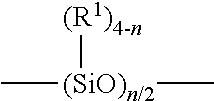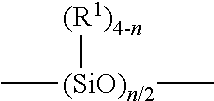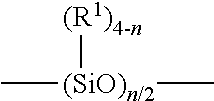Low dielectric photoimageable compositions and electronic devices made therefrom
a composition and low dielectric technology, applied in the field of low dielectric photoimageable compositions and electronic devices made therefrom, can solve the problems of limiting both the thickness and the use of siloxane, the difficulty of processing of liquid or tacky siloxane layers, and the inability to achieve thin coatings, etc., to achieve thicker coatings, improve flexibility and crack resistance, and increase the viscosity of compositions
- Summary
- Abstract
- Description
- Claims
- Application Information
AI Technical Summary
Benefits of technology
Problems solved by technology
Method used
Image
Examples
example 1
[0048]409.74 g of a 90:10 methyl:phenyl silsesquioxane polymer (69.0% solids in propylene glycol monomethyl ether acetate ((PGMEA)), 29.76 g of poly(vinylpyrrolidone-co-vinylacetate) polymer (50% solids in propylene glycol monomethyl ether (PGME) (available from Sigma-Aldrich), and 29.76 g of Irgacure-108 (20.0% solids in methyl iso-butyl ketone (MIBK); available from Ciba) were dissolved in PGME to achieve 60% of total solids.
[0049]The resulting photoimageable dielectric composition was filtered and spin coated onto a 6 inch silicon wafer and soft baked at 90° C. for 60 seconds to obtain a tack-free, crack-free film with a film thickness of 10.1 microns. The photoresist film was patternwise exposed to broadband light on an Ultratech stepper, and post-exposure baked at 80° C. for 60 seconds. This was followed by 30 second puddle development with a 2.38 wt % tetramethylammonium hydroxide (TMAH) developer to resolve features with a film thickness of 9.6 micron. Cross-sectional Scannin...
example 2
[0053]84.12 g of a 90:10 methyl:phenyl silsesquioxane polymer (69.0% solids in PGMEA), 12.90 g of poly(vinylpyrrolidone-co-vinylacetate)polymer (50% solids in PGME) (available from Sigma-Aldrich), and 1.61 g of Irgacure-108 (20.0% solids in MIBK) were dissolved in PGME to achieve 64.6% of total solids.
[0054]The resulting photoimageable dielectric composition was filtered and spin coated onto a 8 inch silicon wafer and soft baked at 140° C. for 30 seconds to obtain a photoresist film. Then the same formulation was coated on top of the aforementioned wafer again (double coating) and soft baked at 140° C. for 300 seconds to obtain a photoresist film with a film thickness of over 150 microns. The photoresist film was patternwise exposed to broadband light on a Suss Aligner, and post-exposure baked at 80° C. for 80 seconds. This was followed by four times of 90 second puddle development step with a 2.38 wt % TMAH developer to resolve features with a film thickness of 130 micron. X-SEM re...
example 3
[0056]164.39 g of a 90:10 methyl:phenyl silsesquioxane polymer (69.0% solids in PGMEA), 11.94 g of polyvinylpyrrolidone polymer (50% solids in PGME) (available from Sigma-Aldrich), and 11.94 g of Irgacure-108 (20.0% solids in MIBK) were dissolved in PGME to achieve 60% of total solids. The resulting photoimageable dielectric composition was filtered and spin coated onto a 6 inch silicon wafer and soft baked at 95° C. for 60 seconds to obtain a photoresist film with a film thickness of 10.5 microns. The photoresist films were patternwise exposed to broadband light on an Ultratech stepper, and post-exposure baked at 90° C. / 60 s, 95° C. / 60 s, and 100° C. / 60 s, respectively. This was followed by a 30 second puddle development step with a 2.38 wt % TMAH developer to resolve features with a film thickness of approximately 10 microns. The resulting patterned dielectric film was then baked at 250° C. for 60 minutes on a hotplate under a nitrogen atmosphere.
[0057]The cured dielectric films o...
PUM
| Property | Measurement | Unit |
|---|---|---|
| glass transition temperature | aaaaa | aaaaa |
| dielectric constant | aaaaa | aaaaa |
| Tg | aaaaa | aaaaa |
Abstract
Description
Claims
Application Information
 Login to View More
Login to View More - R&D
- Intellectual Property
- Life Sciences
- Materials
- Tech Scout
- Unparalleled Data Quality
- Higher Quality Content
- 60% Fewer Hallucinations
Browse by: Latest US Patents, China's latest patents, Technical Efficacy Thesaurus, Application Domain, Technology Topic, Popular Technical Reports.
© 2025 PatSnap. All rights reserved.Legal|Privacy policy|Modern Slavery Act Transparency Statement|Sitemap|About US| Contact US: help@patsnap.com



